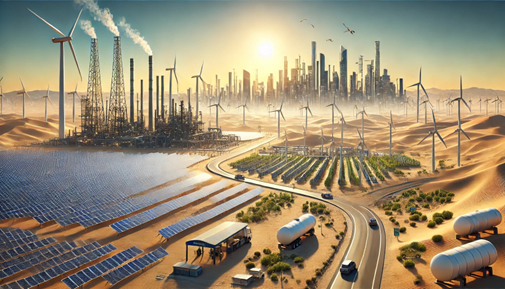Energy Transition in MENA Region
Challenges & Opportunities
BLOG POSTS
Amal Ismail


There is no doubt that the Middle East and North Africa region (MENA) is blessed with many sources of energy, whether fossil fuels (oil and natural gas), which are mainly the source of energy, or renewables (solar and wind energy) in addition to hydroelectricity and other types of clean energy. The MENA region total has around 22% to 26% of global solar radiation. According to international data, each square kilometer in the region can produce solar energy equivalent to 1-2 million barrels of oil per year, which could meet half of the world's electricity needs. Most African countries have average wind speeds of 7–10 m/s, making them highly suitable for large-scale wind power projects. Moreover, governments across the region are increasingly supporting energy transition and climate change initiatives.
The Urgency of Energy Transition
The global transition towards renewable energy has become imperative, particularly in response to rising carbon intensity contributing to global warming and intensifying climate change. MENA region is a major producer of greenhouse gases and one of the regions most vulnerable to climate change. The International Energy Agency (IEA) has emphasized that investments in clean energy must be tripled by 2030 to mitigate climate risks. Furthermore, the IEA projects that consumption of the three primary fossil fuels will decline this decade due to the rapid expansion of renewable energy and electric vehicles. Consequently, accelerating the energy transition in the MENA region is essential not only for addressing the climate crisis but also for ensuring long-term economic resilience.
Challenges Facing the Energy Transition in the MENA Region
Financing Renewable Energy Projects
Transitioning to renewable energy requires substantial financial investment. Total energy sector investments in the Middle East reached approximately $175 billion, with clean energy accounting for only 15% of this amount. In Africa, clean energy investments represent about 2% of global energy investment, underscoring the urgent need for increased funding for renewable energy projects.
Energy Infrastructure Development
Integrating renewable energy sources into existing power grids necessitates significant upgrades. Many electricity grids in the region are outdated and not equipped to handle large-scale renewable energy generation, requiring additional investment in infrastructure.
Political and Regulatory Challenges
Government subsidies for fossil fuels remain a significant barrier to the widespread adoption of renewable energy. Redirecting these subsidies toward clean energy projects requires strong political commitment and policy reforms. According to the International Monetary Fund (IMF), fossil fuel subsidies in MENA doubled between 2020 and 2022, reaching approximately $340 billion, which hinders investment in renewable energy initiatives.
Ambitious Strategies for Energy Transition
Several MENA countries have set ambitious targets for achieving net-zero emissions. The United Arab Emirates (UAE) and Oman have committed to achieving net-zero emissions by 2050, while Saudi Arabia, Bahrain, and Kuwait have set a target for 2060. Additionally, the UAE has pledged to reduce emissions by 19% by 2030 compared to 2019 levels. Egypt has also committed to generating 42% of its electricity mix from renewable sources by 2030, although it has highlighted the necessity of international support to achieve this target.
Therefore, more than one-third of the expected growth in renewable energy capacity is concentrated in Saudi Arabia, followed by the UAE, Morocco, Oman, Egypt, Israel, and Jordan. These seven countries account for 90% of the growth in renewable energy capacity in the region.
In conclusion, while the energy transition in the MENA region presents significant opportunities for economic and environmental sustainability, it also requires overcoming financial, infrastructural, and policy-related challenges. Accelerating the transition needs strong government policies, international cooperation, and increased investment in renewable energy technologies and capacity building.
References:
Address
No 10, Block 28023
3rd District, Obour City, Egypt
Contacts
+201100899991
Careers


Copyright © EUMENA 2024
Terms and conditions
Privacy Policy
Commercial Reg.
105282
